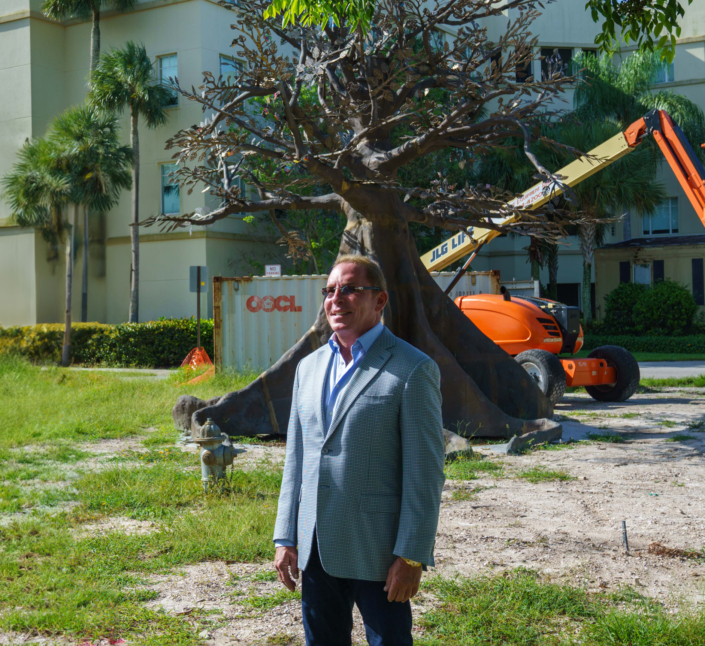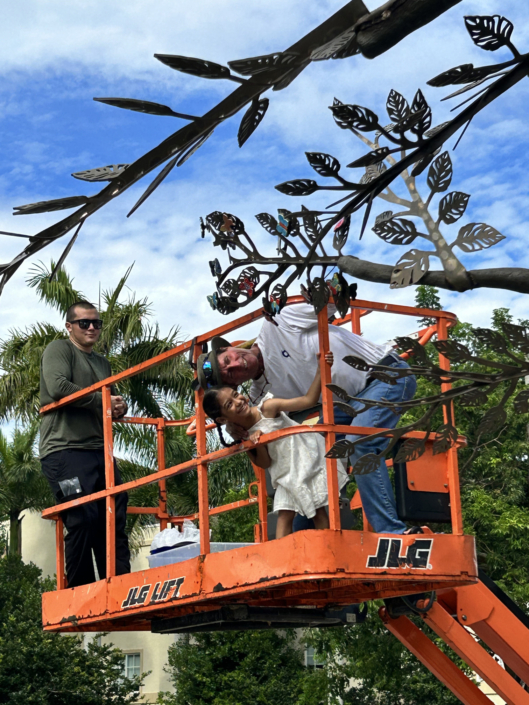The Gendelman Children’s Holocaust Memorial to be integral part of the Holocaust Learning Experience and serve as a beacon for Holocaust remembrance and education
A monumental memorial that takes the form of a tree–cast from 32,000 pounds of bronze–by Palm Beach-based artist, Bruce Gendelman, will soon stand as a moving tribute to Holocaust awareness and education on the MorseLife Health System campus.
Scheduled to be completed this fall, the memorial will serve as a beacon for Holocaust remembrance and education as part of MorseLife’s commitment to teaching the lessons of the Holocaust through the Holocaust Learning Experience (HLE) presented by MorseLife NEXT GENERATIONS.
“The horrific facts of the Holocaust are almost beyond comprehension and impossible to discuss without getting emotional,” said Keith A. Myers, MorseLife’s President and CEO. “Bruce’s vision for what we have named the Gendelman Children’s Holocaust Memorial will provide a touchstone for reflection as students, families, and members of the community have the opportunity to meet with Survivors, their descendants, and our educators one-on-one.”
Rising 25 feet from its base of majestic roots and branching into a 28-foot wide canopy, the memorial is inspired by kapok trees, which are sacred in many cultures for providing protection and linking the earth with the sky. The “tree” will serve as home to 5,000 ceramic butterflies painted by Survivors, temple congregations, MorseLife residents, and local students as part of the worldwide Butterfly Project honoring the 1.5 million children who were murdered by Nazis. The sculpture will ultimately be surrounded by a tranquil butterfly garden on the Morselife campus, encouraging visitors to pause and reflect. The Gendelman Children’s Holocaust Memorial will stand as one of the nation’s largest bronze sculptures.
“Kapok represent strength and resilience,” Gendelman said. “Their roots are deep and broad; their trunks are massive, their branches embracing – they stand up to the enormous winds of hurricanes. The millions of lost lives represented by the delicate and colorful butterflies deserve such a mighty and ‘living’ memorial.”
Hidden within the tree’s canopy are the ruins of a concentration camp’s chimney, a symbol Gendelman often uses in his large-scale Holocaust paintings as a reminder that we must remain vigilant against evil.
The HLE uses the lessons of the Holocaust to enlighten and embolden present and future generations to be “upstanders” and not bystanders against bigotry and hate wherever it exists. The collaboration between Gendelman and HLE is an outgrowth of the MorseLife NOW for Holocaust Survivors Initiative that serves impoverished Holocaust Survivors and their families in Palm Beach County.
“Survivors repeatedly tell us their greatest concern is that the lessons of the Holocaust will be forgotten when the witnesses to the horrors pass on,” said Myers. “The powerful impact of Bruce’s awe-inspiring memorial, combined with an engaging program of Holocaust education, is designed to fulfill our commitment to NEVER FORGET.”

The Making of the Gendelman Children’s Holocaust Memorial
The massive undertaking of modeling, engineering, and casting the memorial involves some 100 craftsmen and engineers. Every aspect has been painstakingly designed over the course of four years to withstand South Florida’s climate and extreme weather events.
The memorial was cast piece-by-piece using the lost-wax method, the same 6,000-year-old process used in the ancient Middle East, Asia, and Europe. The tree is comprised of more than 300 individual castings welded together on-site. Branching off the cast bronze limbs are 150 leafy branches water-jet cut from bronze plate. Each of the 5,000 butterflies will be nested in a 3D printed plate for protection, and individually arranged and secured to the sculpture by the artist.
The Artist’s Personal Connection to His Work
Gendelman’s practice encompasses landscape, portraiture, the Holocaust, and the COVID pandemic in a variety of media, including oil painting, sculpture, photography, and multi-media installations.
The artist’s paternal grandfather, David Neubauer, escaped to the United States prior to WWII. Tragically, only four dozen of the 48,000 Jews in his small town in Ukraine survived the Holocaust. Gendelman’s father, Max, was an American sniper on the front lines of the Battle of the Bulge.
Gendelman’s work stands in opposition to those who would deny the Holocaust. His body of post-witness Holocaust artwork has been the focus of solo exhibitions at the National Museum of American Jewish History, the Holocaust Memorial Center, and the Palac Sztuki in Krakow, Poland, a museum that once served as a Nazi headquarters.

